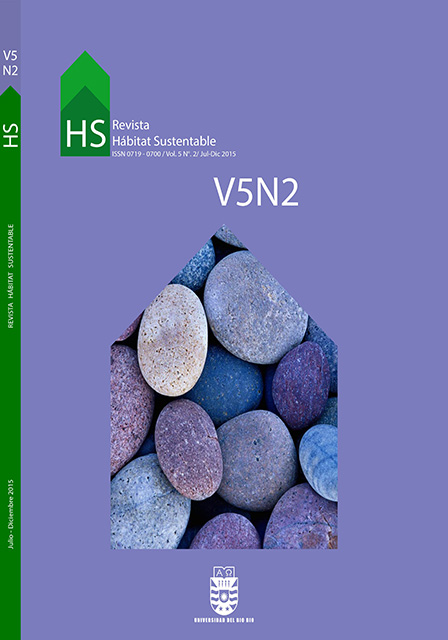Aplicabilidad de estrategias genéricas de diseño pasivo en edificaciones bajo la influencia del cambio climático en Concepción y Santiago, Chile
Palabras clave:
cambio climático, adaptación climática, confort adaptativo, estrategias de diseño pasivoResumen
Las estrategias de diseño pasivo en arquitectura y el comportamiento energético de la edificación normalmente se cuantifican en base a archivos climáticos que, por lo general, no consideran las predicciones del clima. Este artículo profundiza en la generación de datos climáticos futuros y su influencia en el confort higrotérmico, así como en las estrategias de diseño arquitectónico genéricas de adaptación desde el punto de vista pasivo. Con ese fin, se han generado determinados escenarios climáticos para Concepción y Santiago, dos de las conurbaciones urbanas más pobladas de Chile, para los años 2020, 2050 y 2080. Las predicciones se han realizado para el escenario más extendido de emisiones de Gases de Efecto Invernadero GEIA 2 “medium-high”, según el Intergovernmental Panel on Climate Change IPCC. Los niveles de confort se han examinado desde una perspectiva adaptativa, considerando estrategias de diseño genéricas, ambos modelos recogidos en la ASHRAE. Al analizar los pronósticos climáticos con los modelos de confort, se obtienen resultados para una mejor comprensión del grado de adaptación del usuario y la arquitectura al posible clima futuro. Esta investigación genera estrategias genéricas para optimizar el diseño de construcciones en Chile.
Descargas
Citas
AHSRAE STANDARDS COMMITTEE. Thermal Environmental Conditions for Human Occupancy: 2013. Atlanta, American Society of Heating, Refrigerating and Air-conditioning, 2013.
AHSRAE TECHNICAL COMMITTEE. ASHRAE Handbook of Fundamentals: 2005. Atlanta, American Society of Heating, Refrigerating and Air-conditioning, 2005.
BELCHER, Stephen, HACKER, Jacob y POWELL, Diana. Constructing design weather data for future climates. Building Services Engineering Research and Technology [En línea]. 2005, nº26, pp. 49-61. [Consultado 25 agosto 2015]. DOI: 10.1191/0143624405bt112oa
BOUDEN, Chiheb y GHRAB, Nadia. An adaptive thermal comfort model for the Tunisian context: A field study results. Energy and Buildings. [En línea]. 2005, nº37, pp. 952–963. [Consultado 25 agosto 2015]. DOI: 10.1016/j.enbuild.2004.12.003
ENERGY DESIGN TOOL UCLA. [en línea]. [Consultado 28 agosto 2015]. Disponible en: http://www.energydesign-tools.aud.ucla.edu/
ERIKSEN, Siri, ALDUNCE Paulina, SEKHAR, Chandra, D’ALMEIDA, Rafael, MOLEFE, John Isaac, NHEMACHEN, Charles, O’BRIEN , Karen, OLORUNFEMI, Felix, PARK, Jacob, SYGNA, Linda y ULSRUD, Kirsten. When not every response to climate change is a good one: Identifying principles for sustainable adaptation. Climate and Development [En línea]. 2011, nº3, pp. 7–20. [Consultado 25 agosto 2015]. DOI: 10.3763/cdev.2010.0060
FANGER, Povl Ole. Thermal Comfort.1ª ed. Copenhangen: Danish Technical Press, 1970.
FERIADI, Henry y WONG, Nyuk Hien. Thermal comfort for naturally ventilated houses in Indonesia. Energy and Buildings [En línea]. 2004, vol. 36, n°7, pp. 614–626. [Consultado 25 agosto 2015]. DOI: 10.1016/j.enbuild.2004.01.011
GUAN, Lisa. Preparation of future weather data to study the impact of climate change on buildings. Building and Environment [En línea]. 2009, nº44, pp. 793-800. [Consultado 25 agosto 2015]. DOI:10.1016/j.buildenv.2008.05.021
GIVONI, Baruch. Man, Climate and Architecture. 1ª ed. Amsterdam/London/New York: Elsevier Publishing Company Limited, 1969.
HUMPHREYS, Michael y NICOL, Fergus. Adaptive thermal comfort and sustainable thermal standards for buildings. Energy and Buildings [En línea]. 2002, vol. 34 nº6, pp. 563–572. [Consultado 25 agosto 2015]. DOI: 10.1016/S0378-7788(02)00006-3
INTERGOVERNMENTAL PANEL ON CLIMATE CHANGE. Climate Change 2014: Synthesis Report. Contribution of Working Groups I, II and III to the Fifth Assessment Report of the Intergovernmental Panel on Climate Change: 2014. Ginebra: IPCC, 2014.
JENTSCH, Mark F., BAHAJ, AbuBakr S. y JAMES, Patrick A. B. Climate change future proofing of buildings - Generation and assessment of building simulation weather file. Energy and Buildings [En línea]. 2008, nº40, pp. 2148–2168. [Consultado 25 agosto 2015]. DOI: 10.1016/j.enbuild.2008.06.005
MET OFFICE. Met office Hadley centre [en línea]. [Consultado 28 agosto 2015]. Disponible en: http://www.metoffice.gov.uk/climate-change/resources/hadley
MYLONA, Anastasia. The use of UKCP09 to produce weather files for building simulation. Building Services Engineering Research and Technology [En línea]. 2010, vol. 33, n°1, pp. 51-62. [Consultado 25 agosto 2015]. DOI: 10.1177/0143624411428951
OFICINA DE CAMBIO CLIMÁTICO. Plan Nacional de Adaptación al Cambio Climático: 2014. Santiago: Ministerio del Medio Ambiente, 2014.
ROBERT, Amélie, KUMMERT, Michaël. Designing net-zero energy buildings for the future climate, not for the past. Building and Environment [En línea]. 2012, nº55, pp. 150-158. [Consultado 25 agosto 2015]. DOI: 10.1016/j.buildenv.2011.12.014
SCHIERMEIER, Quirin. The real holes in climate science. Nature [En línea]. 2010, vol. 463, n°7279, pp. 284–287. [Consultado 25 agosto 2015]. DOI: 10.1038/463284a
UNIVERSITY OF SOUTHAMPTON. Sustainable Energy Research Group [en línea]. [Consultado 28 agosto 2015]. Disponible en: http://www.energy.soton.ac.uk/ccworldweathergen/
U.S. Department of Energy [en línea]. [Consultado 28 agosto 2015]. Disponible en: http://apps1.eere.energy.gov/buildings/energyplus/weatherdata_about.cfm
Descargas
Publicado
Cómo citar
Número
Sección
Licencia
El contenido de los artículos que se publican en cada número de Hábitat Sustentable, es responsabilidad exclusiva de los autores y no representan necesariamente el pensamiento ni comprometen la opinión de la Universidad del Bío-Bío.
Los autores/as conservarán sus derechos de autor y garantizarán a la revista el derecho de primera publicación de su obra, el cuál estará simultáneamente sujeto a la Licencia de Reconocimiento de Creative Commons CC BY-SA que permite a otros compartir-copiar, transformar o crear nuevo material a partir de esta obra con fines no comerciales, siempre y cuando se reconozcan la autoría y la primera publicación en esta revista, y sus nuevas creaciones estén bajo una licencia con los mismos términos.











 Programa de Información Científica/Concurso Fondos de Publicación de Revistas Científicas 2018/ Proyecto Mejoramiento de Visibilidad de Revistas UBB (Código:FP180007)
Programa de Información Científica/Concurso Fondos de Publicación de Revistas Científicas 2018/ Proyecto Mejoramiento de Visibilidad de Revistas UBB (Código:FP180007) 





